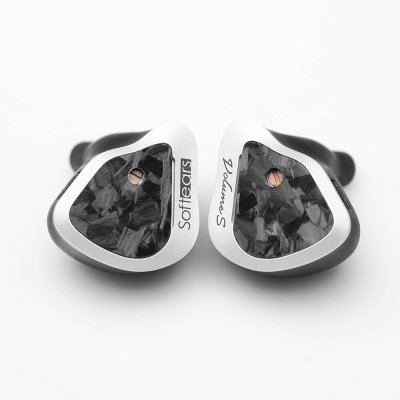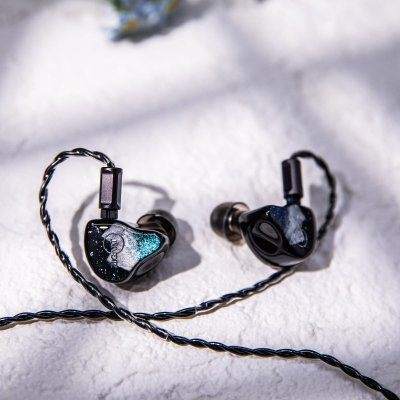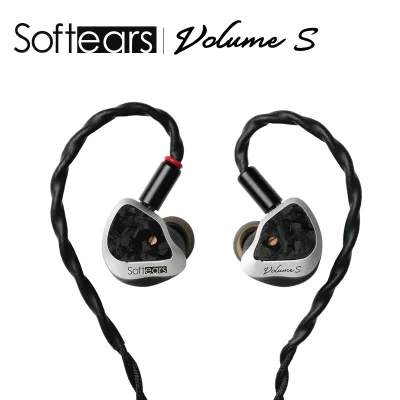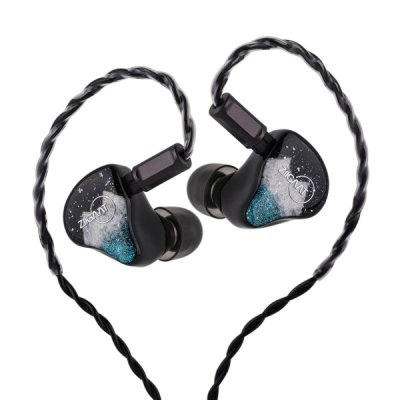Softears Volume S and Ziigaat Horizon use 2DD+2BA and 1DD+2BA+2Planar driver setups respectively. Softears Volume S costs $320 while Ziigaat Horizon costs $329. Ziigaat Horizon is $9 more expensive. Ziigaat Horizon holds a slight 0.1-point edge in reviewer scores (7.8 vs 7.9). Softears Volume S carries a user score of 8.2. Ziigaat Horizon has better treble with a 0.6-point edge, Ziigaat Horizon has better dynamics with a 0.5-point edge, Ziigaat Horizon has better soundstage with a 0.9-point edge, Ziigaat Horizon has significantly better details with a 1.3-point edge and Ziigaat Horizon has significantly better imaging with a 1.3-point edge.
Insights
| Metric | Softears Volume S | Ziigaat Horizon |
|---|---|---|
| Bass | 7.9 | 7.9 |
| Mids | 7.9 | 8 |
| Treble | 7.5 | 8.1 |
| Details | 6.9 | 8.2 |
| Soundstage | 7.2 | 8.1 |
| Imaging | 7.1 | 8.3 |
| Dynamics | 6.8 | 7.3 |
| Tonality | 8 | 7.9 |
| Technicalities | 7.4 | 8.4 |
Softears Volume S Aggregated Review Score
Average Reviewer Scores
Average Reviewer Score:
7.8Strongly Favorable
Ziigaat Horizon Aggregated Review Score
Average Reviewer Scores
Average Reviewer Score:
7.9Strongly Favorable
Reviews Comparison
Softears Volume S reviewed by Super* Review
Youtube Video Summary
The Softears Volume S at $320 sets a new tonal benchmark for IEMs in its price range. It arrives in solid packaging featuring a zippered carry case (a bit large but functional), protective earpiece pockets that might feel overkill for some, and two excellent sets of ear tips – including Softears' own highly-regarded Ultra Clear tips. Build quality is generally fantastic, highlighted by a resin shell, a comfortable paracord-style cable with a low-profile, user-swappable termination system, and recessed 2-pin connectors. While the aesthetics might feel a bit old-school to some, the fit is comfortable and stable due to its semi-custom shape and longer nozzle, making it secure enough for sleeping. A small screwdriver-adjustable tuning switch offers a secondary, brighter Harmon-like sound signature, though the default tuning is preferred.
The default sound signature is a warm-tilted neutral, delivering exceptional natural timbre and tasteful bass boost. This bass stands out for its exceptional physicality – punchy and impactful without being overbearing – alongside articulate sub-bass that’s easy to follow. Combined with well-defined transients, particularly in the upper-midrange, it creates a satisfyingly rich and dense presentation. While spatial effects and imaging are competent but not standout, the overall tonality and bass quality are remarkably refined. Comparisons show it offers a better tonal balance and bass control than the bassier Dunu DaVinci, significantly more body and richness than the brighter, thinner Moondrop Blessing 3, and trades blows with the Moondrop Dusk – the Volume S providing superior density and mid-bass presence versus the Dusk's more open, spacious presentation.
Ultimately, the Softears Volume S earns a full five-star rating. It might not be the absolute most technically dazzling IEM, but its fantastic tonal balance, unique bass physicality, and overall refinement make it a compelling choice. For $320, it delivers a sound signature that feels just right – rich, satisfying, and universally appealing – challenging more expensive offerings and establishing itself as a top contender in its class.
Super* Review original ranking
Super* Review Youtube ChannelBuy Softears Volume S on HiFiGO
Ad
Price: $290
Buy Softears Volume S on HiFiGO
Ziigaat Horizon reviewed by Super* Review
Youtube Video Summary
The Horizon aims for a neutral-natural tonality with a slightly lean lower midrange, delivering standout vocal transparency and crisp separation. Bass is mostly sub-bass focused—felt and supportive rather than boomy—giving notes a pleasing sense of density without smearing the mids. The trade-off is an elevated upper-treble that adds air and detail but can tilt gritty/sandy if the fit or tips aren’t dialed in.
Build and accessories are a mixed bag: a surprisingly nice carrying case and swappable termination, but a fussy cable and a resin shell that fits deep and may need shorter, grippier tips to shine. Once seated well, the Horizon’s imaging and instrument separation pop, making complex mixes feel organized and engaging.
Versus pricier hype pieces with similar FR, the Horizon feels like a “short king” take: not as refined up top as the best of them, yet more weighty and satisfying than some leaner peers. Compared to something like Volume S at a similar price, this set is clearer and more incisive (better separation), while Volume S is fuller and smoother with punchier bass presence. At $330, it’s the most compelling entry in its family so far—addictive for transparency and staging, with the caveat of treble sensitivity and fit quirks.
Super* Review original ranking
Super* Review Youtube ChannelBuy Ziigaat Horizon on Linsoul
Ad
Price: $329
Buy Ziigaat Horizon on Linsoul
Softears Volume S reviewed by Jaytiss
Jaytiss Youtube Channel
Ziigaat Horizon reviewed by Jaytiss
Youtube Video Summary
The ZiiGaat Horizon arrives as the brand’s first tribrid at around $330, pairing one dynamic driver with two BA and two planar drivers. Build is solid: a vented, flat 2-pin socket, metal nozzle, and a distinctive blue-white faceplate that looks like mountains under stars. The cable feels premium with red/blue channel dots and a working chin slider, plus an easy swappable plug (3.5 mm); the included zip case is pleasantly sturdy. Nothing flashy in shell shape, but the fit is secure and the accessories feel thoughtfully sorted.
Sonically, Horizon takes a clean, sub-bass-focused route with bass that reads linear and occasionally a touch pillowy, followed by full, rich upper mids and a treble presentation that steals the show. There’s generous upper air and extension with a tactful lower-treble rise, kept in check by a helpful 5–6 kHz dip to avoid fatigue; a splash of ~15 kHz energy adds sparkle that treble fans will relish. The result sidesteps the “EQ’d-to-death” flatness—this tuning carries just enough color to stay engaging while remaining clean and controlled.
Against peers, Horizon’s top end feels more refined than ZiiGaat’s Luna, while Crescent plays thicker and more V-shaped with extra 10 kHz “twinkle.” Versus sets like the SL224, Horizon’s treble is smoother and less sibilant; compared with Punch Audio Martillo, think of Horizon as the treble-head counterpart to a bass specialist. It also mirrors some strengths of AFUL Performer 7 but with cleaner bass and a more polished top end, and it offers more microdetail than the hard-to-find YU9 Chuer. Taken together, this is a special package: a well-built, distinctive tribrid with 10/10 treble energy and air, competitive technicals, and a tuning that treble lovers will find hard to put down.
Jaytiss Youtube Channel
Softears Volume S reviewed by Audionotions
Ziigaat Horizon reviewed by Audionotions
Softears Volume S reviewed by
 Fresh Reviews
Fresh Reviews
Youtube Video Summary
The Softears Volume S delivers a fantastic hybrid sound in its low impedance mode, characterized as a warm neutral tuning with a lush note weight, good bass punch without bloat, and a slight upper-midrange emphasis that makes vocals pop. This signature translates exceptionally well across both music listening and competitive gaming, offering great separation, layering, and phenomenal imaging for precise positional awareness. While engaging and non-fatiguing, gunfire and intense effects in games like Apex Legends can sometimes feel on the verge of shouty or slightly occlusive during chaotic, high-level scenarios, lacking that last bit of air and resolution in the upper mids.
Gaming performance shines across multiple titles. The Volume S provides outstanding depth perception and accurate imaging for Apex Legends slides and light footsteps, excels in Valorant with its separation and verticality, handles the chaos of Call of Duty exceptionally well, and proves to be a top recommendation for Fragpunk due to its loud, precise, and easily trackable footsteps. The smaller resin chassis offers great comfort and ergonomics, especially for those struggling with fit, though it doesn't feel quite as premium as some metal competitors in its price range.
Significant drawbacks include the utterly dismissed high impedance mode tuning, deemed "absolute garbage" and a headache for gaming, and the fragile tuning mechanism itself, prone to easy damage. The included shoelace-style cable is functional with a removable termination but not a favorite, and the unboxing experience, while decent with a pleather case, extra termination, and two sets of silicone tips, is fairly typical for the price. Ultimately, the Softears Volume S stands as a killer all-around IEM when locked into its excellent low impedance mode, highly recommended for its crossover appeal despite the useless tuning switch and build quibbles.
Fresh Reviews original ranking
Fresh Reviews Youtube Channel
Ziigaat Horizon reviewed by
 Fresh Reviews
Fresh Reviews
Youtube Video Summary
Ziigaat Horizon arrives as a striking tri-brid in the ~$300 bracket (1DD + 2BA + 2 planar) with a tuning that brushes close to Kiwi Ears Astral yet comes across a touch thinner and more balanced. The low end focuses on sub-bass rumble that’s tight, clean, and richly tactile, while mids keep timbre accurate and treble stays controlled—never shouty or fatiguing—yielding a fun-yet-almost-reference presentation. Build and comfort impress: ergonomic shells with that aqua-to-silver fade can be worn for 8-hour sessions, and the package includes Ziigaat’s new two-pin cable with interchangeable terminations (3.5/4.4), a roomy faux-leather case, silicone sets plus foams; tip rolling (e.g., ASMR tips) pairs well.
In games, ambient clutter drops away and crucial cues get spotlighted with confident imaging, separation, and convincing verticality. Footsteps in Valorant are clear and positional, though the lightest taps can blur a bit under nearby low-end rumble or heavy gunfire; Apex performance is exceptional, just a hair behind Astral/Mangird Tea Pro when ultimates stack; Call of Duty delivers satisfying impact with disciplined decay, though micro-cues can soften during chaos. Net-net, Horizon is a great all-rounder with clean, technical bass and a natural balance that works across titles. On the WallHack list it gets A– overall (A– in Apex, B+ in CoD, Valorant just shy of top marks), primarily nudged down by occasional masking of the lightest cues during intense mixes.
Fresh Reviews original ranking
Fresh Reviews Youtube ChannelSoftears Volume S reviewed by Jays Audio
Youtube Video Summary
The Softears Volume S emerges as a standout vocal specialist under $500, often described as a "mini studio 4“ due to similar frequency graphs. However, it trades some treble detail for superior scaling and a heightened focus on the mid-range, particularly vocals, while adding a touch more mid-bass oomph. This treble reduction allows the music to breathe, creating a more immersive and musical experience that pulls the listener deeper into the sound compared to the Studio 4, without sacrificing a sense of space or leaving the bass and treble feeling inadequate. Though not bass-heavy or treble-head oriented, the low-end provides enough thump and the highs enough air to avoid sounding lean or dark, resulting in a presentation that's slightly less technical and balanced than the Studio 4 but excels in vocal delivery and engagement.
A key feature is the tuning switch which boosts upper mids and treble while lowering the bass, effectively transforming the sound into a cleaner, more technical version of Harman 2019, even surpassing the Studio 4 in detail retrieval in this mode. However, this boosted configuration can sound shouty, lean, and overly clinical for many preferences, lacking the thickness of the stock tuning and scaling less effectively at higher volumes. The stock tuning, preferred for its vocal prowess, truly comes alive with increased volume. The included clear tips are recommended for a slight treble lift and comfort, and the bundled USBC adapter adds a subtle amount of sub-bass rumble, though the low-end remains clean and controlled, reminiscent of leaner sets like the Pilgrim, not providing heavy slam.
While the Studio 4 remains a solid, well-balanced all-rounder, especially on sale around $350, and alternatives like the EM10 (more detailed), Supermix 4 (better value), the Volume S carves its niche with exceptional vocal performance at higher volumes using the stock tuning. Its main drawbacks involve the confusing switch design (requiring opposite positions on each earpiece for the same tuning with no clear indicators) and the pricing debate; using non-branded drivers suggests a more appropriate price point would be $200-$250 rather than $300. Despite these quirks and marketing claims about the passive radiator's role (its actual impact being debatable), the Volume S delivers a great sounding, flexible IEM offering distinct sonic profiles based on volume level and switch position.
Jays Audio Youtube Channel
Ziigaat Horizon reviewed by Jays Audio
Youtube Video Summary
Ziigaat’s Horizon follows the current meta-inspired recipe—think Astral, Metas, Crescent—but pushes the focus upward: the treble is the most prominent piece here. It’s bright-leaning without turning harsh, giving a crisp, “OCD-like” sense of transient bite and pinpoint imaging. Low end and vocals sit a touch behind the highs, so the presentation feels clean and lively rather than thick; at mid-volume, the top end drizzles detail over the mix like raindrops—engaging and textured, not shouty.
On the technical side, Horizon pulls strong detail retrieval and resolution for the price—above sets like Supermix 4 and near EM10/Volare —yet it doesn’t scale massively because of that treble lift. The bass is snappy and controlled, with good separation, but lacks the slam and rumble seekers of impact will want. Pairing and playlist matter: avoid hot, highly produced pop/K-pop/J-pop or most hip-hop where the combo of elevated highs and lighter bass can feel edgy; it shines with slower pop, R&B, indie acoustics, ballads, and classical where the sparkle reads as “high-fidelity.” Warmer sources help a bit, and tip-rolling (stock black/clear, or bass-adding options like Final E/divinus) can balance things—just skip anything that pushes treble further.
Against close competitors, Astral hit harder down low and feel more V-shaped and contrasty; Crescent is warmer and smoother but not as clear or micro-detailed. Horizon is the cleanest and brightest of the trio, with the most refined treble focus and “tickly” transients. Verdict: a value-minded all-rounder for detail lovers who prefer clarity and air over bass authority—technical, tidy, and energetic at sensible volumes, provided the library isn’t a treble minefield.
Jays Audio Youtube Channel
Softears Volume S reviewed by Paul Wasabii
Youtube Video Summary
Softears Vol S leans into a mid-bass emphasis that is uncommon among recent hybrids, pairing boosted sub- and mid-bass with full-bodied, lower-mid vocals. The result is a naturally thick, lush midrange that favors genres needing body over sparkle, and the relaxed treble beyond ear-gain lets volume changes scale bass and treble together. At higher listening levels the set can hit hard and verge on bass fatigue, but within moderate levels it fills a clear gap left by leaner U-shaped tunings.
Trade-offs are plain: the upper-treble sits back, so stage is smaller and overall resolution is lower versus airier peers; some upper-end information gets masked by the bass weight. The impedance switch adds a bit of brightness but also trims the pleasing volume scaling, bringing limited benefit. Not a $300 class leader, yet a well-tuned alternative for listeners who prioritize natural, weighty mids over maximum air and sparkle.
Paul Wasabii Youtube Channel
Ziigaat Horizon reviewed by Paul Wasabii
Youtube Video Summary
ZiiGaat Horizon is a $329 tribrid (1DD+2BA+2MPL) that prioritizes treble extension, clarity, and very sharp imaging. Compared with EPZ P50 and Daybreak, ear-gain is set lower, which yields less shout and more natural vocals while keeping an even transition from lower to upper treble. The result is a clean, transparent presentation that reads more refined than typical $300 hybrids and feels end-to-end coherent.
The trade-offs sit mostly in the low end and upper-treble edges: the stock mid-bass dip reduces body and impact, and sibilants can pop, especially around 8 kHz. Bass quality itself is quick and tidy with good depth rather than rumble, matching BA/MPL speed but leaning lean for bass-heavy genres. A light EQ lift of lower mids/mid-bass (about 2–3 dB) and a small 8 kHz trim (around 0.5–1 dB) makes it a more versatile daily driver while preserving its separation and sense of stage depth.
Paul Wasabii Youtube Channel
Softears Volume S reviewed by Z-Reviews
Youtube Video Summary
The Softears Volume S offers a dramatic transformation through its impedance switch, requiring a tiny screwdriver to toggle between low (9.8 ohm) and high (31.2 ohm) modes. The low impedance mode is described as painfully clinical, bland, and annoyingly sterile across all tested amplifiers. It’s reminiscent of the disliked original Volume model, lacking any enjoyable tuning despite EQ attempts. This mode only suits listeners craving absolute neutrality, offering little musical engagement.
Switching to the high impedance mode completely revolutionizes the experience. It becomes relaxed, unoffensive, and remarkably smooth, with notes possessing a lingering, church-like resonance that adds emotional depth. This mode presents music with a spacious, uplifting quality and a subtle chest-felt pressure during resonant passages. However, it demands quality amplification to shine and benefits from tip-rolling; the included sticky liquid silicone tips enhance the signature, though alternatives like Azla SednaEarfit can tweak the response. Comfort and build are excellent, though the fabric cable exhibits some microphonics.
Priced around $300, the Volume S earns a cautious recommendation primarily for its stellar high-impedance performance. It requires tinkering with tips and sources to reach its potential and faces stiff competition in its price bracket. While not an outright class leader, it’s a significant upgrade over the original Volume. The package includes a luxurious case, multiple tips, and a branded USB-C adapter, reflecting Softears' typical attention to detail. Just keep it locked in high-impedance mode.
Z-Reviews Youtube Channel
Ziigaat Horizon reviewed by Z-Reviews
Youtube Video Summary
Ziigaat’s Horizon goes for a flashy tribrid recipe—1×10 mm bio-dynamic for slam, 2×BA for mids, and dual planar treble up top—wrapped in pretty shells and “horizon” art. Street price hovers around $329, though bundle quirks can drop it to roughly $283. The cable is the familiar modular “big boy” plug system (3.5 mm/4.4 mm), chunky but perfectly usable, and the case/tips kit is typical Ziigaat: practical with a dash of theatrics.
Sonically, this one is bold and a bit unnatural—in a good way. Think W-shaped: bass, mids, and treble all step forward, almost competing for attention. The low end hits with big, big bass energy when the track calls for it yet doesn’t trample everything on softer material. Stage is not very wide—more focused and up-front—but there’s satisfying detail/decay and an aggressive, engaging center image. Expect excitement and texture over air and spread, and expect some fatigue after long sessions.
Call it an interesting outlier rather than a safe neutral. Price/performance feels fine (the sweet spot would be closer to $250), and it fits Ziigaat’s “many flavors, similar price” playbook. For listeners stacked with natural-tuned sets and craving a different, punchy, attention-grabbing presentation, Horizon delivers; for chill, long-haul listening, there are calmer choices.
Z-Reviews Youtube Channel
Softears Volume S reviewed by Head-Fi.org
Ziigaat Horizon reviewed by Head-Fi.org
Softears Volume S (more reviews)
Softears Volume S reviewed by Audio Amigo
Youtube Video Summary
Softears Volume S follows the 2022 Volume and steps into a fiercely competitive ~$320 bracket with a seriously premium kit: a gorgeous leather case, modular screw-on terminations, both standard and Ultra Clear eartips, IM booties, and tiny screwdrivers for the on-board potentiometer. The stealthy black resin shells with exposed carbon-fiber faceplates feel solid and fit well thanks to slim nozzles; just note there’s no nozzle mesh. The big caveat is the cloth-sheathed stock cable—ergonomically nice but with heavy microphonics. Two tunings are selectable: low-impedance (≈10Ω) and high-impedance (≈31Ω). The low-impedance mode is the keeper; it’s easy to drive yet sensitive to source output impedance, so a dongle under 1Ω is recommended to avoid unintentionally shifting the tonality.
In low-impedance mode the signature is neutral-natural, a flatter, more mid-centric take on “new-meta.” Bass offers quality over quantity: textured, punchy, and responsive without tipping into basshead territory. The mids are the star—clean, warm-tinged lower mids give male vocals body while female vocals sit forward without shout, keeping timbre natural. Treble is smooth, airy, and non-fatiguing, avoiding metallic glare while preserving sparkle. Technical performance is confidently above average for the price: imaging & stage feel wide and well-layered, with good separation and resolution that rewards attentive listening without forcing it.
Positionally, think “Kato upgrade”: smoother treble, better bass texture, and a refinement that many will prefer. Versus spicier rivals like DaVinci, Project Meta, Dusk DSP, or Mega 5 EST, the Volume S sounds more controlled and “correct,” trading some slam and upper-air fireworks for coherence and timbre. It won’t thrill bass lovers, treble heads, or detail chasers seeking a spotlighted presentation; everyone else gets a superb all-rounder that feels benchmark-worthy—the HD600/650 vibe for IEMs. Verdict: you should buy this if a do-it-all, neutral-natural tuning is the goal; just mind your source impedance and consider swapping the cable to kill the microphonics.
Audio Amigo Youtube Channel
Softears Volume S reviewed by Audio-In Reviews
Youtube Video Summary
The Softears Volume S comes as a well-built hybrid with a clever impedance dial that lets listeners choose between a more vocal-focused high-impedance tuning and a warmer, bass-boosted low-impedance mode. Build quality, modular cable and accessories feel premium for the price, and comfort is solid despite a slightly larger shell.
In high-impedance mode, bass is on the relaxed side with modest sub-bass presence, which can make the overall presentation a touch lean, but the trade-off is incredibly natural mids. Vocals in particular sound beautiful, with female voices, acoustic guitars and strings rendered with convincing timbre and a forward yet controlled upper midrange. Treble is smooth, detailed and non-fatiguing, sitting at a sweet spot where it avoids harshness or sibilance while staying energetic enough to match the midrange focus.
Low-impedance mode keeps that natural mid and treble balance but adds a tasteful bass and mid-bass lift, giving the Volume S more warmth, body and dynamic punch. Kick drums hit harder, male vocals gain extra weight and the overall presentation becomes more engaging and physical, with only a slight hint of bass bleed that rarely distracts. Technical performance is about average in stage width but offers good separation, layering and slightly above-average detail, and combined with its excellent tonal balance and lifelike reproduction of instruments and vocals, this tuning makes the Volume S a standout, even among strong competitors under $500.
Audio-In Reviews original ranking
Audio-In Reviews Youtube ChannelSoftears Volume S reviewed by Gizaudio Axel
Gizaudio Axel original ranking
Gizaudio Axel Youtube ChannelSoftears Volume S reviewed by Tim Tuned
Youtube Video Summary
The Softears Volume S delivers a distinctly colored sound signature with significant boosts in two key areas: the bass and the upper mid-range. Its bass profile is uniquely elevated up to around 300Hz, resulting in a physical, heavy, yet well-defined low end that impresses with substantial note weight and attack, appealing even to bass enthusiasts. Vocals cut through clearly due to the upper mid-range boost, but this tuning comes with a trade-off: a noticeable sense of hollowness and a narrower soundstage that can feel congested on certain tracks, creating a love-hate relationship with its presentation.
The treble offers a safe, natural, and polite character, providing adequate detail without excessive brightness or roll-off, though it may lack sparkle for some listeners. Technically, the Volume S performs at a level comparable to the Moondrop Blessing 3, excelling particularly in the incisive attack and substantial weight behind each note. When compared to competitors, the Volume S edges out the Tea Pro in bass quality, separation, and natural timbre, though the Tea Pro offers a wider stage. Against the Blessing 3, the Volume S trades openness and cleanliness for a more fun, bass-forward and impactful experience. It also presents a more balanced signature than the brighter, more treble-focused Kiwi Ears Astral.
Ultimately earning an A-minus rating, the Volume S is highly recommended for those seeking exceptional bass quality and a fun, colored tuning. However, it might not suit listeners prioritizing a wide soundstage, a neutral signature, or a bright, sparkly treble with forward micro-details; these listeners are advised to audition first.
Tim Tuned Youtube Channel
Softears Volume S reviewed by Smirk Audio
Ziigaat Horizon (more reviews)
Ziigaat Horizon reviewed by ATechReviews
Youtube Video Summary
The ZiiGaat Horizon comes with a solid accessory package for its price, including a spacious hard case, a modular 3.5 and 4.4 cable that is soft and easy to manage, and a good selection of silicone and foam tips that seal well and feel comfortable. The resin shell with metal lip nozzle feels stable in the ear, with venting that avoids pressure build up or driver flex and an average size that sits securely even when walking around. The colorful faceplate with sparkles, flat two pin connector and overall ergonomics make the Horizon look and feel like a well built, everyday friendly in ear.
Sonically the tuning leans sub bass focused at a neutral level, delivering tight, clean, textured bass with natural decay and a strong sense of physicality that stays neatly separated from the mids so vocals and instruments remain clear. The midrange is mostly neutral and very clear sounding, with vocals sitting nicely forward without becoming shouty and a balanced note weight that gives male voices depth and female voices an open, airy quality. Separation and timbre in the mids are excellent, making instruments sound realistic and well layered while clear forward vocals remain free of harshness.
The lower treble on the Horizon is smooth, controlled and detailed without obvious peaks, while the boosted upper treble brings a crisp, airy, sparkly character with plenty of shimmer and micro detail on cymbals, hi hats and upper harmonics, though listeners sensitive to upper treble may find it a touch bright. Overall treble avoids sounding splashy or metallic and works with the open bass and midrange to give the set a spacious, airy feel. In terms of technical performance the Horizon is one of the more resolving options at this price, offering excellent detail retrieval, separation and imaging, and in comparisons it tends to trade the heavier bass and warmth of rivals like Crescent, Astral, Kir SPET, Volume S, Sivo 24 or Zens T Pro for cleaner mids, more upper treble air and clearer vocals, making it ideal for listeners who value clarity and vocal focus over sheer low end quantity.
ATechReviews Youtube Channel
Ziigaat Horizon reviewed by Web Search
Ziigaat Horizon is a tribrid IEM that combines 1DD + 2BA + 2 planar drivers, positioned at an MSRP of $329; this configuration aims to split bass, mids, and treble duties across specialized transducers for coherence and headroom. These fundamentals are confirmed on the brand’s product page and storefront listings.
Subjectively, community impressions describe robust sub-bass from the dynamic driver, clean mids from the BAs, and airy treble from the planar tweeters, with multiple listeners highlighting a notably expansive soundstage. Head-Fi reviews and threads also call out treble extension claims “up to 40 kHz” and above-average staging for the price class.
In tuning terms, the Horizon trends U-shaped: lifted bass and upper-treble energy provide excitement and perceived width, while midrange presence is more neutral than forward—favorable for pop and electronic but less ideal if you prioritize warm, intimate vocals. Reports also note that pairing and tips can influence perceived brightness and staging, so synergy matters if you’re treble-sensitive.
Softears Volume S Details
Driver Configuration: 2DD+2BA
Tuning Type: Neutral with Bass Boost
Brand: Softears Top Softears IEMs
Price (Msrp): $320
Support our free service! Buying through our affiliate links costs you nothing extra:
Ziigaat Horizon Details
Driver Configuration: 1DD+2BA+2Planar
Tuning Type: Neutral, Neutral with Bass Boost
Brand: ZiiGaat Top ZiiGaat IEMs
Price (Msrp): $329
Support our free service! Buying through our affiliate links costs you nothing extra:
Softears Volume S User Review Score
Average User Scores
Average User Score:
Based on 2 user reviews
8.2Very Positive
Ziigaat Horizon User Review Score
Average User Scores
Average User Score: n/a
Based on 0 user reviews
No user reviews yet. Be the first one who writes a review!
Softears Volume S Gaming Score

Gaming Score & Grade
- The gaming score is prioritizing technical capabilities of the IEM (Separation, Layering, Soundstage) and good value.
Gaming Score
8.3Gaming Grade
A+Ziigaat Horizon Gaming Score

Gaming Score & Grade
- The gaming score is prioritizing technical capabilities of the IEM (Separation, Layering, Soundstage) and good value.
Gaming Score
8.7Gaming Grade
S-Softears Volume S Scorings
Average Technical & Tuning Grades
Average Tunign Grade
A+- Tuning feels well executed, keeping a natural flow across the spectrum. Switching genres feels seamless.
Average Technical Grade
A-- A competent technical showing keeps separation intact while delivering modest staging. It feels tidy even when recordings stack layers.
Ziigaat Horizon Scorings
Average Technical & Tuning Grades
Average Tunign Grade
A- It presents a smooth, well-integrated tonal balance that plays nicely with many styles. It maintains natural timbre across the range.
Average Technical Grade
A+- You get an articulate, polished performance with immersive stage depth and great control. There's a sense of polish across the whole spectrum.
Softears Volume S User Reviews
Share your experience and build your personal ranking list.
You need to be signed in to write your own reviewA well-rounded, coherent IEM that shines in low-impedance tuning with excellent midrange clarity.
Pros
Balanced, natural midrange with solid bass and rich accessories.Cons
High-impedance mode feels unnecessary and shells may be bulky for small ears.RSV with more bass quantity and better quality, at less than half the price.
Pros
Very nicely balanced sound signature for all-rounder duties, with tonality and technical performance that punches above its price. More even sub - mid bass profile which results in a more cohesive, better textured bass vs harman/meta tuned sets.Cons
Pinna gain isn't an ideal fit for my HRTF, hearing slightly too much upper-mid emphasis after extended listening and comparisons. Upper treble is lacking air vs more expensive sets, most evident in cymbal hits coming across dulled, not unlike the RSVZiigaat Horizon User Reviews
"This is an example review"
Pros
- Example pro 1
- Example pro 2
Cons
- Example con 1
- Example con 2
Share your experience and build your personal ranking list.
You need to be signed in to write your own reviewFind your next IEM:
IEM Finder Quiz
newIEM Comparison Tool
newVS



































